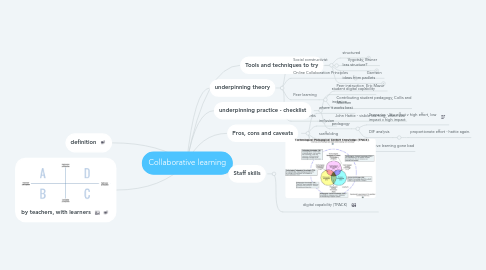
1. underpinning theory
1.1. Social constructivist
1.1.1. Vygotsky, Bruner
1.2. Online Collaboration Principles
1.2.1. Garrison
1.3. Peer learning
1.3.1. Peer instruction, Eric Mazur
1.3.2. Contributing student pedagogy, Collis and Moonen
1.4. Why it works
1.4.1. John Hattie - visible learning, effect size
2. by teachers, with learners
3. Staff skills
3.1. digital capability (TPACK)
4. Pros, cons and caveats
4.1. where it works best
4.2. inclusion
4.3. scaffolding
4.4. essay mills
4.4.1. collaborative learning gone bad
4.5. student perceptions
5. underpinning practice - checklist
5.1. student digital capability
5.2. inclusion
5.3. pedagogy
5.3.1. Scenarios - low effort v high effort, low impact v high impact
5.3.2. DIF analysis
5.3.2.1. proportionate effort - hattie again.
6. Tools and techniques to try
6.1. structured
6.1.1. discussion forums
6.1.2. mailing lists
6.1.3. Tricider
6.1.4. voicethread
6.2. less structure?
6.2.1. google docs
6.2.2. etherpad
6.2.3. textwall, padlet, realtimeboard etc
6.2.4. mindmapping
6.2.5. instagram/pinterest
6.2.6. twitter/facebook
6.3. ideas from padlets
6.3.1. Creating artefacts/resources
6.3.2. Problem solving / knowledge exchange
6.3.3. Categorise/prioritise information
6.3.4. Participate in conversations/discussions
6.3.5. Role play/quests
